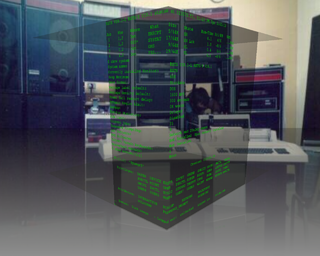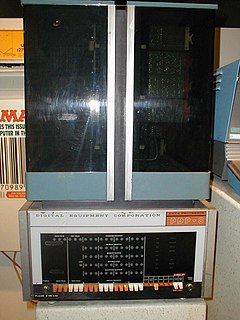A disk operating system is a computer operating system that can use a disk storage device, such as a floppy disk, hard disk drive, or optical disc. A disk operating system must provide a file system for organizing, reading, and writing files on the storage disk. Strictly speaking, this definition does not apply to current generations of operating systems, such as versions of Microsoft Windows in use, and is more appropriately used only for older generations of operating systems.

Digital Equipment Corporation's PDP-10, later marketed as the DECsystem-10, was a mainframe computer family manufactured beginning in 1966 and discontinued in 1983. 1970s models and beyond were marketed under the DECsystem-10 name, especially as the TOPS-10 operating system became widely used.

The PDP-1 is the first computer in Digital Equipment Corporation's PDP series and was first produced in 1959. It is famous for being the computer most important in the creation of hacker culture at MIT, BBN and elsewhere. The PDP-1 is the original hardware for playing history's first game on a minicomputer, Steve Russell's Spacewar!

The PDP-11 is a series of 16-bit minicomputers sold by Digital Equipment Corporation (DEC) from 1970 into the 1990s, one of a succession of products in the PDP series. In total, around 600,000 PDP-11s of all models were sold, making it one of DEC's most successful product lines. The PDP-11 is considered by some experts to be the most popular minicomputer ever.

RSX-11 is a discontinued family of multi-user real-time operating systems for PDP-11 computers created by Digital Equipment Corporation. In widespread use through the late 1970s and early 1980s, RSX-11 was influential in the development of later operating systems such as VMS and Windows NT. It was designed for process control, but was also popular for program development.
RT-11 is a discontinued small, single-user real-time operating system for the Digital Equipment Corporation PDP-11 family of 16-bit computers. RT-11 was first implemented in 1970 and was widely used for real-time systems, process control, and data acquisition across the full line of PDP-11 computers.
OS/8 was the primary operating system used on the Digital Equipment Corporation's PDP-8 minicomputer.

RSTS is a multi-user time-sharing operating system, initially developed by Evans Griffiths & Hart of Boston, and acquired by Digital Equipment Corporation for the PDP-11 series of 16-bit minicomputers. The first version of RSTS was implemented in 1970 by DEC software engineers that developed the TSS-8 time-sharing operating system for the PDP-8. The last version of RSTS was released in September 1992. RSTS-11 and RSTS/E are usually referred to just as "RSTS" and this article will generally use the shorter form.

DECtape is a magnetic tape data storage medium used with many Digital Equipment Corporation computers, including the PDP-6, PDP-8, LINC-8, PDP-9, PDP-10, PDP-11, PDP-12, and the PDP-15. On DEC's 32-bit systems, VAX/VMS support for it was implemented but did not become an official part of the product lineup.

The PDP-4 was the successor to the Digital Equipment Corporation's PDP-1.

The Professional 325 (PRO-325) and Professional 350 (PRO-350) were PDP-11 compatible microcomputers introduced in 1982 by Digital Equipment Corporation (DEC) as high-end competitors to the IBM PC.
The Massbus is a high-performance computer input/output bus designed in the 1970s by the Digital Equipment Corporation of Maynard, Massachusetts.

DECmate was the name of a series of PDP-8-compatible computers produced by the Digital Equipment Corporation in the late 1970s and early 1980s. All of the models used an Intersil 6100 or Harris 6120 microprocessor which emulated the 12-bit DEC PDP-8 CPU. They were text-only and used the OS/78 or OS/278 operating systems, which were extensions of OS/8 for the PDP-8. Aimed at the word processing market, they typically ran the WPS-8 word-processing program. Later models optionally had Intel 8080 or Z80 microprocessors which allowed them to run CP/M. The range was a development of the VT78 which was introduced in July 1977.

The Honeywell 316 was a popular 16-bit minicomputer built by Honeywell starting in 1969. It is part of the Series 16, which includes the Models 116, 316 (1969), 416 (1966), 516 (1966) and DDP-716 (1969). They were commonly used for data acquisition and control, remote message concentration, clinical laboratory systems, Remote Job Entry and time-sharing. The Series-16 computers are all based on the DDP-116 designed by Gardner Hendrie at Computer Control Company, Inc. (3C) in 1964.
BATCH-11/DOS-11, also known simply as DOS-11, is a discontinued operating system by Digital Equipment Corporation (DEC) of Maynard, Massachusetts. The first version of DOS-11 (V08-02) was released in 1970 and was the first operating system to run on the Digital PDP-11 minicomputer. DOS-11 was not known to be easy to use even in its day and became much less used in 1973 with the release of the RT-11 operating system.
TSS-8 is a discontinued time-sharing operating system co-written by Don Witcraft and John Everett at Digital Equipment Corporation in 1967. DEC also referred to it as Timeshared-8 and EduSystem 50.

LINC-8 was the name of a minicomputer manufactured by Digital Equipment Corporation between 1966 and 1969. It combined a LINC computer with a PDP-8 in one cabinet, thus being able to run programs written for either of the two architectures.
Digital Equipment Corporation (DEC), was a major American company in the computer industry. Founded in 1957 with a $70,000 loan, it became "the nation's second-largest computer company, after IBM." Its initial major impact was in minicomputers, but its later-introduced VAX and Alpha systems are still notable.












